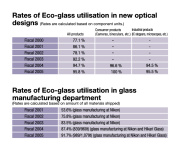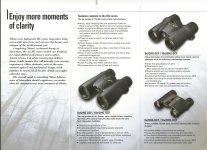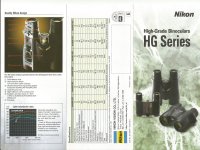Lots of things might make sense, but I keep having trouble distinguishing your speculations from known facts. Does a distinct serial number gap at the time of Eco-glass or coating changes actually exist in either SEs or EIIs, and what is your information source in either case? I haven't taken references to "82xxxx" to mean literally "820000"; why do you? And one speculation doesn't justify another.
It's like Algebra where x stands for a uknown number. I've used that shorthand for years, if not decades on BF, so have others. You've been a member since 2015, I'm surprised this seems confusing. Henry and I just discussed this about the Nikon serial numbering, which started with 500xxx, which Ingraham apparently left off in his review, using only the last one of two digits.
82xxxx means the serial # starts with 82 as the first two numbers, the xxxx is whatever numbers follow it, so it could be from 82xxx1 to how many ever Nikon made so far. I have not seen an 83xxxx 8x E2, so I have to assume Nikon is still on the 82 series.
As to the exact year NIkon changed over to the new coatings, we know that was 2017 with the 100th Anniversary Edition 8x30 E2 since Nikon's 100th anniversary was in 2017. I know, I've got one. According to Andy and other BF members who have 82 serial number 8x E2s, the view is identical to the AE edition. Therefore, the 82 E2s were made in 2017 or later. No speculation necessary.
As to the SEs switchover to Eco-Glass, that's harder to pin down, but I've already provided evidence that any SE made before 2000 could not be made with Eco-Glass since Nikon didn't start making Eco-Glass until 2000 and didn't switch over to lead-free glass in all their binoculars until 2005. I'm not sure why you and Andy are still skeptical about that. He believes what's written in Nikon's booklet that came with his 10x32 LX, why would he and you not believe they told the truth in the document I provided made by Nikon???
Whether or not SEs contained lead-free glass from 2000 to 2005 is not knowable since no-one has produced evidence of that the way Andy has with his 10x32 LX (I sold my previous SEs and didn't get a box and bookelts with the 501 sample I bought from Paul.
However, based on my observations and others on BF (the "Lead is a Good Thing" BF thread) comparing the pre-550 SEs with the 550 model, it
appears that lead glass came later rather than sooner to the SE and LX. I think it happened with the 550, but I can't give more proof than what I've seen through my two eyeballs and others who saw the same thing on BF and CN.
Ditto for the Leica BAs and BNs, though in the case of the Trinovids, there is evidence that late model BAs had lead-free glass. Don't ask me for the evidence, you'll have to do your own homework with that one.
Here is the proof, the HG LX 8 and 10X32 which I still have, were made in 2002, FACT. Note the date on the broschure, ECO glass. Courtesy of Dipped years ago.
So perhaps the coatings changed from the original LX to the LX L but they WERE BOTH LEAD FREE.
View attachment 1497002
View attachment 1497000
Andy,
Thanks! Yep, Nikon changed the LX changed over to lead-free glass before the introduction LXL, but what year? I don't see any year on the documents, but I assume you are anchoring it to 2002 because you bought your 10x32 LX new in 2002?
The views through the LXs I had (8x32, 8x42 and 10x42), which I purchased in 2000 for the first 8x32 and 2001 for the second sample 8x32, 8x42 and 10x42) looked quite different to me than the LXL, which had more CA and different color rendtion, which others in that old BF threads also found.
I don't recall seeing Eco-Glass mentioned in the accompanying literature, just the two usual blue booklets that accompany the SE and LX, the user manual and warranty "card" (booklet). But I included them in the boxes when I sold them, so I no longer have them.
The first sample 8x32 LX had a loose fouser on the level of the Terra ED. Just resting my finger on the focuser would move it. I could spin it about 1/4 of a turn! The second sample was better. I sold the 8x and 10x42 LXs because the low distortion caused "rolling ball" while panning. Too bad, because I really liked the still image of the 10x42 model, but it was also very heavy.
I'm not sure if your brochures mean that pre-2002 LXs also had lead glass or if they all had Eco-Glass and the change in coatings in the LX L accounted for the changes in CA and color rendition. Doesn't make sense that more advanced coatings could increase CA. Certaintly that wasn't the case in the 2017 on 8x30 E2s, which reduced CA. Like the SEs, there's no way to tell for certain.
What I can say and have said is that my observations and others on the "Lead is a Good Thing" BF thread, it would appear that the first LXs might have had lead glass up until 2002, because my observations and others on the "Lead is a Good Thing" thread and on other threads on BF and CN, combined with the study of Eco-Glass vs. Lead Glass in microscopes that I attached to my post, suggests that lead glass binoculars controlled CA better than Eco-Glass.
As the study said, it was due to manufactures not finding suitable subtitutes for the missing ingredients. But I would imagine you've had pre-2017 E2s and the AE edition and the 82 version. I've compared the 2015-2016 801 8x30 E2 (bought new from Japan in 2020, old new stock apparently) vs. the AE 8x30 E2, and the differences are dramatic in terms of CA control, color rendition, and flare control.
So Nikon can now make Eco-Glass that's as good (if not better) than lead glass, but initially, that was not the case.
Brock










